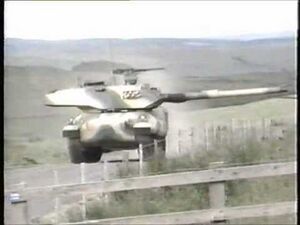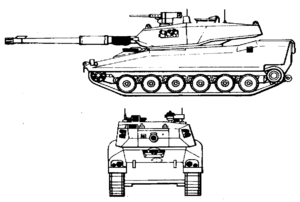PaVå-35: Difference between revisions
No edit summary |
No edit summary |
||
| Line 80: | Line 80: | ||
[[Category:Trinovantum]] [[Category:Weapon Systems in Pardes]] | [[Category:Trinovantum]] [[Category:Weapon Systems in Pardes]] | ||
== See Also == | |||
* [[Ikv-121]] | |||
* [[Mako_Light_Tank|Mako LT]] | |||
* [[T-77 Xabarín]] | |||
Revision as of 16:20, 14 September 2019
This article is incomplete because it is pending further input from participants, or it is a work-in-progress by one author. Please comment on this article's talk page to share your input, comments and questions. Note: To contribute to this article, you may need to seek help from the author(s) of this page. |
| TAG-35 | |
|---|---|
 | |
| Type | Airborne Light tank |
| Place of origin | |
| Service history | |
| Used by | |
| Production history | |
| Designer | Global Defense Land Systems |
| Designed | 1984-1989 |
| Manufacturer | Global Defense Land Systems |
| Produced | 1991-Present |
| Specifications | |
| Weight | 19.8 tonnes (21.8 short tons; 19.5 long tons) |
| Length | 8.61 metres (28 ft 3 in) gun forward |
| Width | 2.69 metres (8 ft 10 in) |
| Height | 2.35 metres (7 ft 9 in) |
| Crew | 4 (commander, gunner, loader, driver) |
| Armor | Welded Aluminium and high hardness steel |
Main armament | 1 x Alban Arsenal GHC-11 105mm L/52 rifled cannon |
Secondary armament | 1 x GAM-24 coaxial chain gun
1 x IAM-43 or CAM-74 machine gun (Optional) |
| Engine | 9.0L V6 turbo-diesel engine 552 hp |
| Power/weight | 28 hp/tonne |
| Suspension | torsion bar |
| Ground clearance | 410 millimetres (1 ft 4 in) |
| Fuel capacity | 570 L (150 US gal) |
Operational range | 483 km (300 mi) |
| Speed | 70 km/h (43 mph) |
The TAG-35 is a Trinovantan airborne light tank designed and produced by Global Defense Land Systems to supplement the ATAG-26 in Trinovantan rapid deployment forces.
Development
In the early 1980s, the Trinovantan Army was convinced of the need of a heavier air-transportable fire support vehicle for use in rapid deployment forces. At the time, airborne forces could only rely on the ATAG-26 and other variants of the Universal Light Chassis for this role, and the aging 8 tonne platform was deemed to be insufficiently armed and armored for the direct fire support role in the modern era. To address these concerns, the Trinovantan military held an open competition under the Next Generation Light Armoured Vehicle (NGLAV) program to replace the Universal Light Chassis. Requirements for the NGLAV's light tank were stringent; it could weigh no more than 20 tonnes, must fit within all currently in-service transport aircraft, had to be at least as mobile as the ULC vehicles it was to replace, had to be resistant to up to 20mm autocannon fire along the frontal axis, and it had to mount either the GHC-11 105mm rifled cannon or the GHS-23 120mm smoothbore cannon for ammunition commonality.
In 1986, NGLAV physical trials began. Of the 13 proposals originally submitted at the start of the program, five viable prototypes were available for testing. At the conclusion of these trials, three vehicles were discarded as not sufficiently meeting the standards of the NGLAV program. The other two vehicles that remained were determined to meet the standards as set by the program, but had other faults that must be corrected. The Global Defense Land Systems proposal, while conforming to the original size restrictions, was shown to be too large to safely transport within some of the smaller transport aircraft in service with the Trinovantan military. The other proposal from the Haswell Defense Company, which had opted to use the more powerful GHS-23 modified with an automatic loader, suffered from issues with the recoil from firing its cannon. A second round of trials were scheduled for 1989 in order to test more refined variations of the two proposed vehicles.
In perpetration for the 1989 trials, the Haswell proposal underwent a series of modifications. The turret was lengthened to accept a new hydro-pneumatic recoil damper, the cannon was fitted with a newly designed muzzle brake, and the torsion bar suspension was replaced with an advanced active hydropneumatic suspension. The GLDS proposal received a slightly modified hull which set the original proposal's turret slightly deeper into the hull and at a 3 degree forward tilt. This modification allowed the GLDS proposal to meet the new size requirements set for the 1989 trials. When the trials began, the Haswell proposal held a clear advantage over the GLDS proposal in all fields except for crew protection and ease of maintenance, where the GLDS proposal held a slight and significant advantage respectively. However, the modifications made to the Haswell proposal had also significantly increased the projected production and maintenance costs of the vehicle. Due to these factors, the GLDS vehicle was selected for service.
Armament
The primary armament of the TAG-35 is Alban Arsenal's GHC-11 rifled cannon. When selected for use on the TAG-35, the GHC-11 had already been in service in the Trinovantan military for over 30 years, and a large and diverse stockpile of ammunition was available. In addition to modern depleted uranium armour-piercing fin-stabilized discarding sabot and high-explosive anti-tank rounds, large stockpiles of high-explosive squash head and anti-personnel canister rounds exist in storage. While the GHC-11, even when firing modern armour-piercing ammunition, is considered to be inadequate against most modern main battle tanks, it is sufficiently powerful for the TAG-35's role as a fire support vehicle. The TAG-35 can carry up to 41 rounds of ammunition for the GHC-11, with up to 19 rounds stored ready-to-use within the fighting compartment.
The TAG-35 is also equipped with a GAM-24 8mm coaxial chain gun. The 8mm chain gun provides several unique advantages over contemporary coaxial weapon systems, with the chief advantage being reliability. The GAM-24 has demonstrated the ability to constantly fire for up to 20 minutes without stopping and a mean rounds-before-failure rate of 50,000 in normal operations. It is also compact and easily configurable to feed from either side of the weapon. Spent shell casings are ejected forward using a long tube under the gun, which deposits the casings outside of the vehicle. As an electrically driven chaingun, the GAM-24 must receive power from the vehicle in order to function. The TAG-35 typically carries 3000 rounds for the GAM-24. A pintle mount for a IAM-43 general-purpose machine gun is present forward of the commander's hatch, with a mount for the CAM-74 heavy machine gun being developed for the vehicle in 1999.
Protection
The majority of the TAG-35's passive armor profile is that of military-grade aluminium, chosen so that the TAG-35 could remain under the 20 tonne weight limit imposed by the NGLAV program. Key areas on the front hull and around the turret are reinforced with high-hardness steel plates to augment protection. This gives the TAG-35 protection against 20mm projectiles with limited protection against 25mm projectiles from the frontal arc and all aspect protection against 12.7mm armor-piercing projectiles.
In the event of a penetration into the fighting compartment of the vehicle, several countermeasures are in place to mitigate damage. A modern spall liner is installed along the interior of the vehicle to reduce spall fragmentation from armor perforation. Automatic fire extinguishers are present in the engine bay and the crew compartment, and a blow out panel is installed above the ammunition storage in the fighting compartment. The vehicle features an overpressure system to protect the crew from CBRN threats. Up to 12 grenade dischargers can be fitted to the front of the TAG-35's turret to provide obscuring smoke.
Mobility
Vroom vroom
Sensors and Systems
It’s got good seeing glass
Operational History
>implying
Variants
- TAG-35: Airborne Light Tank
- TAL-35: Heavy Kinetic ATGM carrier
